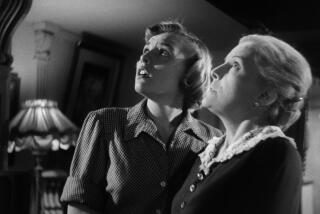Tarr’s ‘Harmonies’ Is Involving Puzzle
- Share via
Bela Tarr’s beautiful and confounding “Werckmeister Harmonies,” which screens at the Los Angeles County Museum of Art on Friday at 7:30 p.m. and Saturday at 6 p.m. and 9 p.m., generates remarkable tension between its sheer visual power and its implacable elusiveness. As wearying as the film becomes in its long, bleak sequences, its uniquely cinematic and emotion-charged experience makes the effort worthwhile.
It opens in a drab workingman’s bar in a drab Hungarian town as it is about to close for the night--but not before a saintly young man, Janos Valuska (Lars Rudolph) leads the men to act out, in a dirge-like dance, the workings of the cosmos during an eclipse, after which he assures everyone that “the sun will rise again.”
Janos makes himself useful to others around the clock, helping care for a frail musicologist, Gyorgy Eszter (Peter Fitz), who has banished his despised--but not to be underestimated--wife, Tunde (a deglamorized but ever-commanding Hanna Schygulla).
While delivering the local paper late at night, Janos encounters an immense truck rumbling into the town’s huge open square. It contains the stuffed remains of “the world’s largest giant whale,” attended by a barker called Prince, who has developed into a Hitler-like rabble-rouser, attracting hundreds of discontented men to the square. The crowd grows more restless, especially with the nonappearance of both the whale and the Prince, ever closer to raging out of control. By the end of this harrowing work, Tarr suggests there’s nothing to be done when irrational forces overtake society but to try to survive and endure until they pass, like an eclipse. (323) 857-6010.
*
As part of the Museum of Contemporary Art’s Andy Warhol retrospective, the facility is presenting the first of a three-part Warhol film series that is by far the most comprehensive ever assembled in Los Angeles. The first part (Friday through July 26) will screen at the Pacific Design Center; the second, in cooperation with the American Cinematheque, at the Egyptian (July 31-Aug. 28). The third is composed of three programs of screen tests, which are running continuously in MOCA’s Ahmanson Auditorium beginning at noon each day. Approximately two-thirds of the films have never been shown locally.
Warhol’s earliest films, virtual home movies shot in grainy black and white, are by and large extended put-ons and travesties; yet on occasion they attain the level of camp pathos. They feature the denizens of Warhol’s famous Factory and celebrate a languid, sometimes druggy sexuality that in tone are alternately outrageous, striking and sometimes just plain tedious. Warhol’s work was part of an underground cinema emerging in the ‘60s that offered a jolting contrast to the mainstream movies of the time.
The first program, Friday at 7 p.m. in the SilverScreen Theater at the Pacific Design Center, opens with the three-minute “Elvis at Ferus” (1963), in which Warhol pans the camera around La Cienega’s Ferus Gallery, capturing the artist’s reprocessed and repeated life-size images of Elvis Presley in a gunfighter pose and in front of them the gallery’s Irving Blum, who was the first to show Warhol’s work on the West Coast in 1962. It will be followed by the 35-minute “Eat” (1964), featuring a young man wearing a hat and eating an egg--interminably. With the amusing 47-minute “Soap Opera” (1964) Warhol intercuts hilarious ‘50s commercials and infomercials with a series of silent romantic encounters and their travails, focusing primarily on Warhol superstar Baby Jane Holzer tossing her blond mane a lot, and including a couple of moments that wouldn’t be allowed on daytime drama even today. Screening Saturday beginning at noon is “Empire” (1984), an eight-hour portrait of the Empire State Building. (213) 621-1745.
*
Kim A. Snyder’s “I Remember Me,” which begins an open-ended Saturday and Sunday 11 a.m. run at the Monica 4-Plex this weekend, is a consciousness-raising documentary about the mysterious debilitating disease called chronic fatigue syndrome, which strikes people with varying intensity and varying lengths of time. At its worst people can be rendered too weak to get out of bed, sometimes for years on end. As she began to recover from the disease, although at times confined to a wheelchair, Snyder decided to investigate it. Chronic fatigue syndrome, whose onset is similar to an extremely bad case of flu, tends to occur in clusters, such as one in the Lake Tahoe area, where over 300 people were stricken between May 1984 and late 1986, yet no virus has been identified. The elusiveness of the disease has made it much tougher for sufferers to get a positive response from the government; indeed, Snyder discovers that $13,000 intended for its investigation was diverted to other diseases by the national Centers for Disease Control and Prevention.
Veteran director Blake Edwards speaks of struggling with CFS for some 15 years; Olympic gold medalist and women’s World Cup soccer star Michelle Akers tells of being sidelined by it, struggling to regain her health and resume her sports activities; and a Connecticut teenager, ill for three years, tells of his determination to attend his high school graduation, even if it means via a gurney and ambulance. Snyder learns that well-documented accounts of the outbreak of the disease date back at least to the 1950s, yet little has been done to fight the malady. With her graceful, informative film, Snyder has made a big step in the right direction. (310) 394-9741.
*
Early in her career, German director Doris Dorrie won international acclaim for her rueful comedy “Men ...” and now with “Enlightenment Guaranteed,” she again tackles with humor but even more compassion the vicissitudes that can beset ordinary guys. Dorrie has explored spiritual quests before, but her shift in tone from the comic to the serious is exceptional here in its depth and scope. “Enlightenment Guaranteed” is as funny as it is nourishing, and it has stellar performances from Uwe Ochsenknecht and Gustav Peter Wohler, who play off each other like Jack Lemmon and Walter Matthau. Although this 1999 production played a regular local engagement a year ago, it opens the Goethe Institute’s annual Blockbuster series of recent German box-office hits Tuesday at 7 p.m. at the institute, 5750 Wilshire Blvd.
Ochsenknecht’s Uwe and Wohler’s Gustav are fortysomething brothers living in Munich who go on a retreat to a Buddhist monastery near Tokyo. Their adjustment to routines of prayer and household labor is a source of continuing humor, yet Dorrie unobtrusively evokes in them a gradual and genuine spiritual enlightenment.
The great lesson for the West from the East, Dorrie has said, is to learn to live in the present and not for the future. This is what Uwe and Gustav learn, and Ochsenknecht, one of the stars of “Men ...” and Wohler, move between the comic and the serious with ease. (323) 525-3388.
*
The American Cinematheque’s “Haunted World of Italian Horror Maestro Mario Bava” is the largest retrospective ever assembled of the films of the late director, celebrated for a bravura sense of style and the darkly poetic power of his imagery. It will present 18 films, 13 in new 35-millimeter prints, between May 31 and June 12 at the Egyptian Theater. Participants will include Bava’s son and collaborator Lamberto, his producer Alfredo Leone and several of his stars, Barbara Steele, Elke Sommer, Mark Damon and John Saxon.
The series begins Friday at 7:30 p.m. with the U.S. premiere of “Kidnapped” (1974), which remained unfinished for over 20 years until it was assembled for DVD release by Bava authority Tim Lucas with several additional scenes directed by Lamberto Bava and additional music by Stelvio Cipriani. Also known as “L’Uomo e il Bambino” and “Rabid Dogs,” it is a stunning psychological thriller that has been aptly compared to Sam Peckinpah’s “Straw Dogs,” and its raw, on-the-road grittiness stands in stark contrast with Bava’s atmospheric period pieces. A gang of robbers pulls a successful heist of a pharmaceuticals company on the outskirts of Rome only to discover the police on their tail. A bloody standoff in a parking structure leaves four people dead, including one of the robbers. The icy, suave leader of the gang, Doc (Maurice Poli) and his two scruffy henchmen Thirtytwo (Luigi Montefiori) and Blade (Aldo Caponi) take a woman, Maria (Lea Lander), hostage and make their getaway, subsequently taking hostage Riccardo (Riccardo Cucciola), a middle-aged man, with an unconscious boy.
Bava is expert at milking the tension as the bad guys take flight with their captives. He keeps fresh developments coming along that sustain interest but never strain credibility as the psychological aspects of the situation emerge under mounting pressure. Thirtytwo and Blade are crude, volatile and mindless thugs who all but drool over Maria, to the extent that one has to wonder just how much control Doc has over them. “Kidnapped” plays out faultlessly and ends with a twist that really is a shocker. Leone and Lamberto Bava will discuss the film after its screening.
Barbara Steele, star of Bava’s “Black Sunday” (1960), perhaps the most famous of Bava’s films, will discuss it following its 5 p.m. screening Saturday. There will be an 8 p.m. double feature composed of the uncut European version of the director’s reported favorite, “Black Sabbath” (1963), starring Boris Karloff, Mark Damon and Jacqueline Pierreux in a trio of terror tales, and “The Whip and the Body” (1963), a kinky Gothic thriller starring Christopher Lee and Daliah Lavi. Damon will appear between the two films. (323) 461-2020. (Bava’s Legacy, Page 34.)
More to Read
The biggest entertainment stories
Get our big stories about Hollywood, film, television, music, arts, culture and more right in your inbox as soon as they publish.
You may occasionally receive promotional content from the Los Angeles Times.










